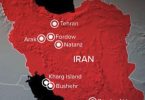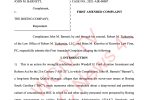TANZANIA (eTN) – Lobbying for global support to combat poaching of elephants and ban bloody ivory trade during Thursday’s international conference to tackle wildlife crime in London, the Tanzania government has blasted the British media over a recent report which slapped its face with poaching scandals.
In a strong-worded statement issued to the media Tuesday, the Tanzanian government said the report published by the Daily Mail on Sunday and which accused Tanzanian President Jakaya Kikwete of turning a blind eye was one sided, since he has done a historic job in preventing the killing of elephants.
The Daily Mail article carried the headline: “Tanzania slaughters over 11,000 elephants a year for the bloody trade in tusks and its President turns a blind eye.”
Tanzania, however, admitted in its report to see poaching of elephants increase since 2009, reaching an estimated killing of 11,000 jumbos each year.
But when the Tanzanian President is trying his level best to convince other parties to support this country in combating poaching of elephants and illegal, bloody ivory trade, undercover media reports in the country’s capital city of Dar es Salaam had implicated corrupt government officials in wildlife conservation departments with poaching deals.
Media reports had implicated senior government officials in the ministry of Natural Resources and Tourism to be behind poaching of elephants, rhinos, lions, leopards, and live animals, including bird species and reptiles.
Independent conservationists in Tanzania believe President Kikwete’s commitment for the conservation of nature and his personal initiative to combat elephant poaching, but points fingers at a section of political leaders from the ruling Chama Cha Mapinduzi party and wardens in wildlife departments.
Conservationists see President Kikwete as a victim of his own generals whom he trusted to manage Tanzania’s natural heritage. His former, tough and committed Minister for Natural Resources, Mr. Khamis Kagasheki, fell victim to corrupt officials under his political and administrative command.
The once successful Anti-poaching Operation ended up as a political debacle, forcing him to resign prematurely. Now, elephant poachers in Tanzania have gained a momentum to eliminate the just, remaining African jumbos.
The Wildlife Division in Tanzania’s Ministry of Natural Resources has been known as the most corrupt government unit of all, more so than other government administrative departments.
The Wildlife Division manages over 38 wildlife game reserves and game-controlled areas, including the world-famous Selous Game Reserve, covering some 50,000 kilometers in area.
Corruption in the Wildlife Division, Immigration Department, and the Ports of Dar es Salaam and Zanzibar had catalyzed illegal trade in bloody ivory and trade in live animals in Tanzania.
Media reports had so far, revealed identities of big traders of Somali origin and who are involved in the poaching of elephants and rhinos.
Somali nationals, some being suspected to finance terrorist gangs in East Africa, are living and moving freely in Tanzania’s capital of Dar es Salaam, mostly in busy trading spots in the city center.
Large-scale ivory shipments originating from Africa have almost exclusively been seized in containers at major ports in Asia, where there is an established customs inspection system. Shipments have mainly originated from not only Dar es Salaam and Zanzibar in Tanzania but Mombasa in Kenya as well.
Corrupt officials are blamed for failure to monitor Somali nationals in Tanzania living freely as traders during the day and criminals during the night.
Though Chinese nationals have been arrested and implicated in poaching of elephants and trade in bloody ivory, Somali nationals are counted the most dangerous poachers, threatening elephants in Tanzania and Kenya.
In the late 1980s, Tanzania ranked Africa’s second-largest elephant populated country and championed the international ban on ivory trading that was adopted in 1989. Today, it is the epicenter of the poaching epidemic sweeping through the continent’s forests and savannas, making this nation Africa’s elephant slaughter house.
A third of all the illegal ivory seized in Asia comes from or through Tanzania. The country is losing 30 elephants a day, or nearly 11,000 a year. Nearly half the country’s elephants have been shot, speared, or poisoned since 2007, leaving scarcely 60,000 in total.
Selous Game Reserve boasted 70,000 elephants five years ago, now has barely 13,000 signaling Tanzania’s elephant extinction within seven years to come.
The United Nations report titled “Elephants in the Dust” had highlighted the shocking reality of the current poaching crisis. It also spells out some very sensible solutions for stopping it.
African elephants are illegally killed at a rate of 100 per day in ranges states, Tanzania taking one-third of the killing by counting 30 elephants downed by merciless poachers every day.
Chairman of the Parliamentary Committee for Lands and Natural Resources, Mr. James Lembeli, revealed a shocking report of 30 elephants killed per day, only the known figure, while those killed in most remote areas of this country go uncounted.
Achim Steiner, UN Under-Secretary General and UNEP Executive Director says: “The surge in the killing of elephants in Africa and the illegal taking of other listed species globally threatens not only wildlife populations but the livelihoods of millions who depend on tourism for a living and the lives of those wardens and wildlife staff who are attempting to stem the illegal tide.”
Large and previously secure elephant populations in Southern Africa proved that it is not impossible for elephants to live safely in their habitats while benefiting people by generating income through tourism.
John Scanlon, Secretary-General of the Convention on International Trade in Endangered Species (CITES)says: “This report provides clear evidence that adequate human and financial resources, the sharing of know-how, raising public awareness in consumer countries, and strong law enforcement must all be in place if we are to curb the disturbing rise in poaching and illegal trade.”
This African nation had an estimated elephant population of about 350,000 during the early 1960s but during the first wave of elephant poaching in the 1970 and 1980s only 55,000 elephants were left. Their number had doubled to 110,000 heads in 2009 but poaching in recent few years had so far reduced their population again.
In northern Tanzania, elephant population in Mkomazi and Tsavo ecosystem has dropped to 11,000 from the 12,573 recorded in the 2011 census, the Kenya Wildlife Services has said.
The two parks share territorial borders which give elephants from Tsavo in Kenya to cross the Tanzanian border to Mkomazi National Park.
Kenya Wildlife Services said between the 2011 and 2014 elephant census period, more than 800 elephants were lost through poaching in Tsavo and Mkomazi ecosystem.






















